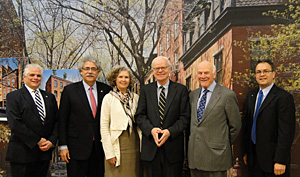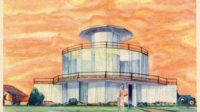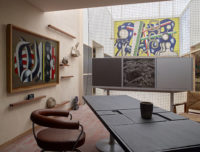
On March 3, sixty people gathered at the AIA headquarters in Washington, D.C., for a panel discussion related to the exhibition, Context\Contrast: New Architecture in Historic Districts, 1967-2009. After being on view at the New York Center for Architecture from October 2009 to January 2010, the exhibition was moved to AIA headquarters.
“It is a historic occasion,” stated Rick Bell, FAIA, executive director of AIANY, at the start of the event. The evening’s subject was only one level of “historical” significance. That the free, public program was taking place at AIA National Headquarters, making it feel more like the “American Center for Architecture” than an association headquarters was another distinction for the event. That two historic district review board heads—Robert Tierney, chair of the Landmarks Preservation Commission (LPC) in New York, and Tersh Boasberg, chair of the Historic Preservation Review Board in Washington, DC—were gathered with practitioners from New York and D.C. for a candid conversation on the approval process added a third level of significance.
Commissioner Tierney spoke about the many challenges and triumphs he has witnessed over the years as a public official and long-time Greenwich Village resident. He mentioned the rare empty lot in a New York City historic district, making an example of Hugh Hardy’s modern 11th Street townhouse (one that replaced the home blown up by the Weathermen, an activist group, in March 1970). What happens when a new building breaks the streetwall, interrupting the otherwise flat progression of buildings? Months, if not years, of debate, he said. While the vast majority of the 10,000 permits that the LPC reviews annually are for more modest revisions, Tierney sounded optimistic about the “handful” of “really radical” proposals that come across his table each year.
Sherida Paulsen, FAIA, is perhaps the only architect who has sat on the LPC, chaired it, and tried to get her projects approved before it. She talked candidly about the 18-month challenge posed by one Brooklyn Heights site, and discussed the impetus for the exhibition. As the New York Chapter’s 2009 president, it was her vision to bring together the experiences of a regulatory agency (the LPC) and a community of innovators (architects practicing in New York) to illustrate an issue that affects 100 local neighborhoods.
On the D.C. side, Chair Boasberg was frank about the trouble modern architecture in historic neighborhoods can cause. After approving one starkly modern house for the historic neighborhood of Cleveland Park—“to show we were serious” about new architecture, he said—other neighborhoods took it as a sign that landmark district designation could not protect your neighborhood. But with 100 districts in New York and 46 in D.C., it’s clear that the designation does positively impact the city by protecting architectural heritage while promoting excellence in design.
Ultimately, the event was historic for a fourth reason: for the first time in memory, the ground floor of AIA National Headquarters was being used as a streetfront gallery. After years of housing office cubes, this was back to how The Architects’ Collaborative originally imagined the space: a brick patio and wall of glass separating the inside from the Octagon. It is fitting that Context\Contrast: New Architecture in Historic Districts, 1967-2009 was the inaugural show in the space (up through April 28). After all, the AIA campus is its own little example of new architecture in a historic context.





Post a comment to this article
Report Abusive Comment